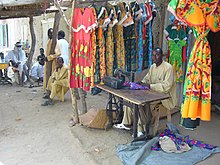Treadle

A treadle (from Old English: tredan, "to tread") is a foot-powered lever mechanism; it is operated by treading on it repeatedly. A treadle, unlike some other types of pedals, is not directly mounted on the crank (see treadle bicycle for a clear example).
Most treadle machines convert reciprocating motion into rotating motion, using a mechanical linkage to indirectly connect one or two treadles to a crank. The treadle then turns the crank, which powers the machine. Other machines use treadles directly, to generate reciprocating motion. For instance, in a treadle loom, the reciprocating motion is used directly to lift and lower the harnesses or heddles; a common treadle pump uses the reciprocating motion to raise and lower pistons.
Before the widespread availability of electric power, treadles were the most common way to power a range of machines. They are still widely used as a matter of preference and necessity. A human-powered machine gives the human operator close, instinctive control over the rate at which energy is fed into the machine; this lets them easily vary the rate at which they work. Treadle-operated machines are also used in environments where electric power is not available to power electric machinery.
Other, similar mechanisms for allowing human and animal muscle to power machines are cranks, treadmills, treadwheels, and kick wheels like a potter's kick wheel.
Operation and uses

A treadle is operated by pressing down on it repeatedly with one or both feet, causing a rocking motion.[1] This movement can then be stored as rotational motion via a crankshaft driving a flywheel. Alternatively, energy can be stored in a spring, as in the pole lathe.

Treadles were once used extensively to power most machines including lathes, rotating or reciprocating saws, spinning wheels, looms, and sewing machines.
Today the use of treadle-powered machines is common in areas of the developing world where other forms of power are unavailable. It is also common among artisans, hobbyists and historical re-enactors.[2]
Some treadle looms in Africa and South Asia use toggles on a string as treadles. The toggles are held between the weaver's toes.

See also
References
- ^ Grodzinski, Paul (2021). A Practical Theory of Mechanisms: Classification and Description of Mechanisms Applied In Machines and Instruments. Berlin: De Gruyter. ISBN 9783112515044.
- ^ Gelber, Steven M. (1999). Hobbies: Leisure and the Culture of Work in America. New York: Columbia University Press. p. 188. ISBN 9780231504232.